Abstract
End-of-life tires (ELTs) are tires, unusable in their original form, which go into a waste management scheme (for recycling and energy recovery purposes), or otherwise are disposed. In New Zealand, the annual disposal of 3.5 million ELTs is posing critical environmental and socio-economic issues, and the reuse of ELTs through large-volume recycling engineering projects is a necessity. In this study, gravel and recycled granulated rubber were mixed to explore the possibility of obtaining synthetic granular geomaterials (with adequate geotechnical and environmental characteristics) that are suitable as structural fills for geotechnical applications including foundation systems for low-rise light-weight residential buildings. Moreover, an original framework with a set of geo-environmental criteria is proposed for the acceptance of gravel–rubber mixtures (GRMs) as structural fills. It is shown that when gravel-size like rubber particles are used, GRMs with volumetric rubber content of 40% or less have adequate strength (ϕ’ > 30°), low compressibility (εv ≤ 3%), excellent energy adsorption properties, and acceptable leachate metal concentration values (e.g., Zn < 1 mg/L), making them ideal synthetic structural fill materials for many sustainable geotechnical applications.
1. Introduction
Tire recycling is the process of converting unwanted end-of-life tires (ELTs)—that can no longer be re-grooved or re-treaded—into materials that can be utilized in new products or applications [1]. While in many countries, ELTs are a controlled waste under stringent environmental protocols, currently no national regulations are in place in New Zealand to properly manage ELT recycling. As a result, rising environmental and socio-economic concerns are commanding the reuse of ELTs by means of large-volume recycling civil engineering schemes. Below, the issues, challenges, and possible solutions to the ELT disposal problem are described with reference to the New Zealand context.
1.1. Issues
Currently, over 5 million ELTs are produced yearly in New Zealand (i.e., one per capita), including four million passenger vehicle tires and one million truck tires. Such numbers are expected to grow over time with increasing volume of vehicles on roads. It is estimated that only 30% of such ELTs are exported or recycled, with the remaining 70% disposed of in stockpiles, landfills, illegal dumping, or otherwise unaccounted for [2,3].
A typical example of inadequate ELT disposal practice in New Zealand is shown in Figure 1. The dumping of scrap tires into landfills is certainly the least appropriate option for the disposal of ELTs. Such practice is unsustainable, causing significant environmental, socio-economical, and health problems such as inappropriate use of valuable land (up to 75% void space), harbor for pests and insects that may spread contagious and unknown diseases [4], potential water and soil contamination due to leaching of metals and other chemicals contained in the scrap tires [1,5,6,7], and the likelihood of uncontrolled fires of stockpiled tires [8,9,10,11,12]. Therefore, there are major benefits in moving away from ELT disposal and implementing sustainable recycling schemes.
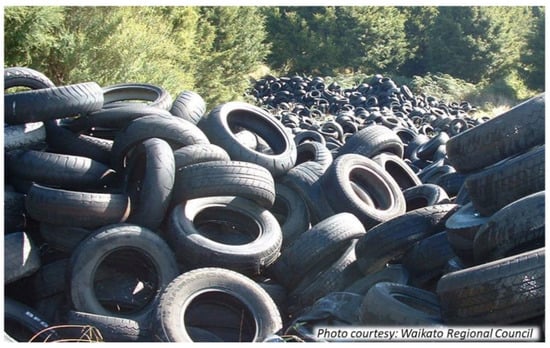
Figure 1.
A typical ELT dumping practice seen in New Zealand.
1.2. Challenges
Tire recycling may be challenging, but it is not impossible to achieve. In Europe, USA, Japan, Canada, and many other countries where strategic environmental procedures have been put in place to effectively make use of recycled ELTs, their disposal has been reduced to 20% or less [2,4,13].
As shown in Figure 2, reduce, reuse, recycle, and energy recovery are the four integrated basic options that should always be considered in dealing with waste management problems [14]. Similar to any other waste, also in the case of ELTs, the highest priority should be to avoid/reduce the generation of waste. This is obviously impractical due to the increasing volume of tired vehicles on roads. The next most preferred options should be reuse (as many times as possible and without further processing) and recycle (making new products) of ELTs. This will keep ELTs in the productive economy and benefits the environment by lessening the need for new materials and waste management. When extra recycling is not achievable, it could be possible to recover the energy from ELTs [15] (but only if environmentally adequate). Finally, only if ELTs could be safely recycled and direct treatment is not feasible, their disposal could become an eventual management alternative.

Figure 2.
Waste management hierarchy applied to ELTs in the New Zealand context (adopted from [16]).
While avoidance/reduction is currently impracticable, ELT reuse and recycling are certainly feasible opportunities, and should be without a doubt preferred to energy recovery and disposal. In this regard, the most promising solution would be to use ELT-derived products as construction materials in sustainable large-scale civil engineering projects.
1.3. Opportunities
Reuse and recycling of industrial by-products, commercial wastes, and construction and demolition materials in geotechnical engineering applications are progressively required in Australasia as it provides important benefits in terms of increased sustainability and reduced environmental impacts [17]. In this setting, coal wash and steel slag mixtures have been reused as structural fills for a port reclamation development [18,19,20], recycled rubber mixed with coal wash and steel slag has been used in rail tracks [21], recycled glass and recycled concrete compounds have been characterized as pavement base [22], and recovered plastic and demolition wastes blends have been engineered as a capping layer for railway applications [23].
Given the above background, and aimed at facilitating the use of ELT-derived products as construction materials in sustainable civil engineering projects in New Zealand, a geo-environmental-structural engineering experimental research program—funded by the Ministry of Business, Innovation and Employment (MBIE)—has been jointly carried out by researchers of the University of Canterbury and the Institute of Environmental Science and Research Ltd. (ESR), Christchurch, New Zealand. Thus far, the main effort of such interdisciplinary research has been the development of “eco-rubber geotechnical seismic-isolation (ERGSI) foundation systems” for low-rise light-weight residential buildings [24,25,26]—readers can refer to the following website for full details of the project: https://sites.google.com/view/ecorubberfoundation/publications (accessed on 19 July 2021). Nevertheless, a series of experimental, numerical, and field investigations have been designed so that they would provide an in-depth understanding of key factors affecting the engineering behavior of soil–rubber mixtures and rubberized concrete, which must be taken into account in the design of such synthetic materials, hence, expediting their adoption not only into ERGSI foundation systems, but also in many other civil/geotechnical engineering applications.
In this paper, the results of the geotechnical and environmental investigations carried out to identify optimum energy-adsorption granular soil-recycled rubber mixtures, possessing excellent mechanical properties (e.g., compaction, compressibility, strength, dynamic properties etc.) and least leaching attributes are presented and discussed.
The results of the structural engineering laboratory tests (to design fiber-reinforced rubberized concrete structural elements, e.g., foundation raft, with satisfactory material and structural performance) and numerical investigations (i.e., DEM and FEM), physical models, and field trials (to verify the concept and assess the mechanical performance of geotechnical and structural elements individually and integrated into systems under both static and seismic load) will be presented elsewhere in due course.
2. Soil-Rubber Mixtures: Practical Implications and Material Suitability
Typically, ELT-derived aggregates (in the form of chips, crumbs, granules and shreds—ASTM [27]) assorted with cohesionless granular soil (mainly sand) have found use as light-weight backfill materials for embankments and retaining walls, drainage systems, slope remediation, and landfill construction [28,29]. However, more recently, due to their superior strength and dynamic properties, soil–rubber mixtures have been proposed as free-draining energy-adsorption backfill material for retaining walls, underground horizontal and vertical layers for liquefaction mitigation [30,31] and geotechnical seismic-isolation systems for residential buildings [32,33,34,35].
As reported in a comprehensive literature review undertaken by Tasalloti et al. [36], previous research has dealt primarily with the physical and mechanical characterization of sand–rubber mixtures. Generally, sand–rubber mixtures have good strength, low-shear modulus, and high damping properties. However, from a practical viewpoint, their high compressibility may result in low bearing capacity and undesirable settlement in the short- and long-term [34], limiting their adoption in many geotechnical applications. Moreover, in the selection of the soil type and recycled rubber size to form soil–rubber mixtures for use in geotechnical applications, the availability and the cost efficiency of both materials should be carefully considered [37,38]. Essentially, to avoid intrinsic segregation of binary assortments made of small and large particles [39,40,41], the recycled rubber should be cut into smaller (sand size-like) particles when mixed with sands. This, in turn, will unavoidably increase the implementation costs. Hence, the use of gravel–rubber mixtures (GRMs) instead of sand–rubber mixes has progressively been recommended.
Taking into consideration that in New Zealand it is a common practice to replace the topmost problematic soil layers (e.g., liquefiable sandy soils and compressible deposits) with well-compacted gravelly soil layers as part of the foundations for residential buildings and other geotechnical works, the adoption of GRMs in such applications seems the most appropriate. However, compared to sand–rubber mixtures, GRMs have been poorly characterized. Therefore, as part of the feasibility study reported in this paper, the physical properties, compaction characteristic, mechanical behavior, dynamic properties, and environmental aspects of different GRMs were evaluated by means of detailed laboratory investigations as described henceforth.
3. Experimental Study
In this study, to evaluate the combined effects of rubber content by volume and the aspect ratio (i.e., the ratio of median particle sizes of the rubber and the gravel, AR = D50,R/D50,G [38,39,40,41,42]) on the physical properties and mechanical response of GRMs, a poorly-graded rounded gravel (G) and two coarse-sized recycled granulated rubber types—namely, large rubber (RL) and small rubber (RS)—were tested. Their particle size distribution (PSD) along with photos are shown in Figure 3, while their index properties are reported in Table 1. The specific gravity (Gs) was measured as 2.71 (G), 1.15 (RL), and 1.14 (RS)—the rubber was free of steel wires and fiber reinforcements. The aspect ratio of G-RL was AR = 0.67 and that of G-RS was AR = 0.33.
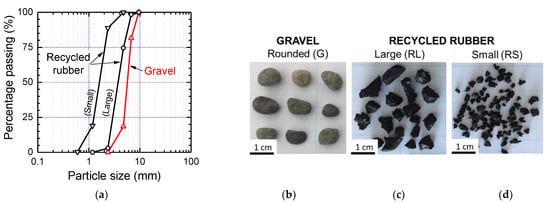
Figure 3.
Material tested in this study: (a) Particle size distribution; and physical aspect of (b) gravel, (c) large rubber particles, and (d) small rubber particles (adopted from [16]).

Table 1.
Index properties of the tested materials.
Several mixtures were prepared at various volumetric rubber content (VRC) of 0%, 10%, 25%, 40%, and 100% by mixing RL and RS with G. Note that, VRC is defined as the ratio of the rubber particle volume (VR) to the total volume of solid particles (VTOT = VR + VG, where VG is the volume of gravel grains), according to Equation (1):
Dry specimens were prepared by tamping method at a degree of compaction of 90% or above (based on standard Proctor tests—refer to details in Section 4.1). Segregation in the specimens was avoided by minimizing any vibration and preventing granular flow.
The one-dimensional (1-D) compressibility of GRMs was evaluated up to 500 kPa vertical stress by means of a medium-size (inner diameter 250 mm; specimen height from 150 mm) compression cell. Alternatively, the shear strength was estimated by using a medium-size (100 mm × 100 mm in cross-section and 53 mm in height) direct shear box under 30, 60, and 100 kPa normal stress levels (the horizontal displacement rate was 1 mm/min). Moreover, to evaluate the small-strain stiffness, shear modulus degradation, and damping ratio of GRMs, two series of bender element and small-strain drained cyclic triaxial tests (specimen size: diameter = 70 mm; height = 170 mm) were also carried out on dry specimens. Additionally, batch leaching tests besides conductivity, pH, total organic carbon (TOC), and inductively coupled plasma mass spectrometry (ICP-MS) analyses were performed to assess key environmental aspects of GRMs. A summary of the geo-environmental tests performed in this study is reported in Table 2.

Table 2.
Summary of geo-environmental tests carried out in this study.
4. Experimental Results
4.1. Compaction Properties of GRMs
For satisfactory performance of structures made of soil–rubber assortments, it is necessary to properly control the compaction and correctly evaluate the physical properties of compacted materials. For the GRMs investigated in this study, vibratory table tests were found to be ineffective due mainly to the low moduli and energy absorption ability of the rubber aggregates. In contrast, Proctor compaction tests resulted in a suitable testing procedure, even if the moisture content was not a controlling factor. On the other hand, the minimum unit weight was simply attained by cautiously pouring the materials in the compaction mold with nearly zero depositional height. Typical results are reported in Figure 4a in terms of dry unit weight variation with VRC.
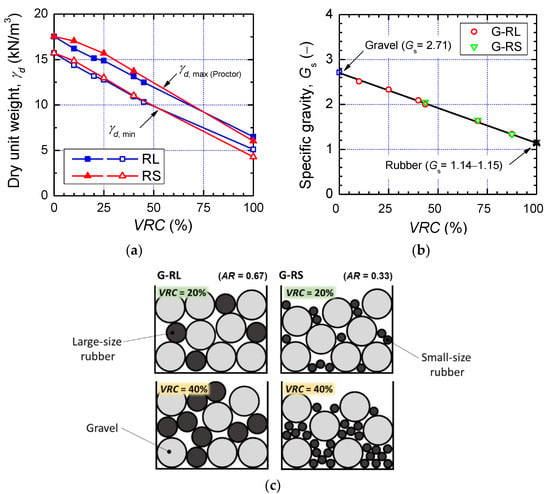
Figure 4.
Density characteristics of tested GRMs: (a) minimum and maximum dry unit weight; (b) specific gravity; and (c) idealized illustration of volume of solids-biased density packing (adopted from [16]).
As the rubber particles are much lighter than the gravel ones (Figure 4b), both the minimum and maximum dry unit weights of GRMs decrease almost linearly by increasing VRC. It is worth mentioning that, at VRC ≤ 40%, the dry unit weight values of G-RS were slightly above the linear trends. This is because at lower VRC values, small rubber particles can easily occupy the large voids between gravel grains (Figure 4c), which results in an increase in the density state of the mixtures [39,40,41]. In contrast, because the size of RL particles is almost similar to that of the gravel, the rubber particles cannot fit in the voids between the gravel grains, even at lower VRC, but rather replace the gravel grains in the mixtures. For completeness, a schematic illustration showing idealized packing density arrangements between gravel and RL and RS particles is reported in Figure 4c for VRC = 20% and 40%.
4.2. 1-D Compressibility of GRMs
Material compressibility (or the capability to increase/decrease in volume when subjected to an applied load) is one of the most important factors required in design considerations. For conventional granular soils with rigid particles (i.e., sand and gravel), any change in volume is due to the rotation, movement, and rearrangement of non-compressible grains [41]. The compressibility of GRMs, however, is completely different to that of granular soils, due to significant differences in the elastic modulus of the rigid particles of the host gravel and that of the soft rubber particles. Furthermore, under normal stress conditions, not much volume change is associated with individual particles of rubber (i.e., this is because the Poisson’s ratio of pure rubber is ν ≈ 0.5), and distortion is the key phenomenon that takes place in pure rubber specimens.
1-D compression test results with creep loading are reported in Figure 5. In the tests, a 2-h creep (which, under the adopted testing conditions, was sufficient to attain negligible settlement under sustained vertical stress) was applied at different incremental loading stages and the measured vertical stress values were corrected for the loss of transferred load (due mainly to soil-wall friction) that was experimentally determined.
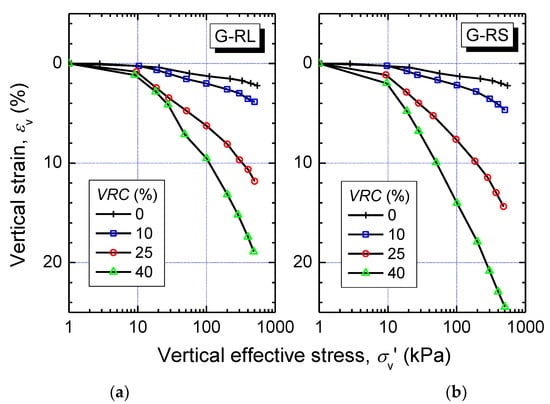
Figure 5.
Compressibility of GRMs in 1-D compression tests with 2-h creep: (a) G-RL and (b) G-RS mixtures.
For any given vertical shear stress level, the trends reported in Figure 5 clearly show an increase in 1-D compression with increasing VRC. Furthermore, it can be seen that GRMs with VRC ≤ 10% performed better than those with VRC ≥ 25% (i.e., much smaller vertical strains (εv) developed under the same applied vertical effective stress (σv’) level). Additionally, in the range of VRC tested, it can be observed that the GRMs made of small rubber particles (AR = 0.33) were much more compressible than those consisting of large rubber particles (AR = 0.67).
4.3. Shear Strength of GRMs
Alike conventional soils, shear strength is one of the most important characteristics contributing to the performance for GRMs. The shear strength is the result of friction and interlocking between particles and likely bonding at particle contacts. Due to interlocking, GRMs may contract or expand in volume as they are subject to shear strains.
The stress–strain–volumetric behavior of G-RL and G-RS attained by direct shear tests at 60 kPa normal stress (σn) is compared in Figure 6. It can be seen that, as VRC increased, the GRM response progressively changed from dilative with a clear peak shear state (gravel-like behavior) to contractive without a peak shear state (rubber-like behavior). Similar tendencies were observed at σn = 30 and 100 kPa.
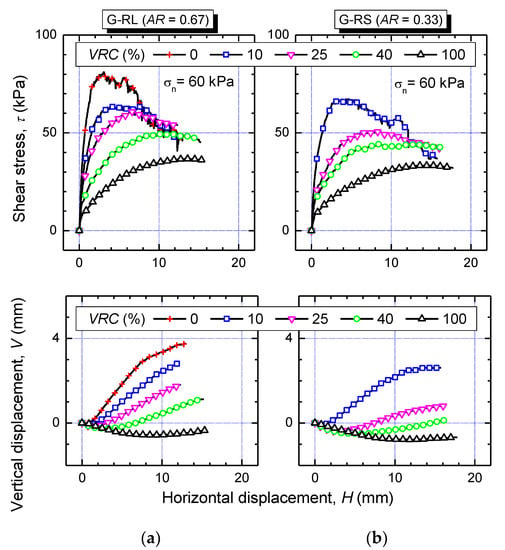
Figure 6.
Direct shear behavior of GRMs at 60 kPa normal stress: (a) G-RL; and (b) G-RS mixtures.
The summary plot reported in Figure 7a shows the change in maximum shear stress (τmax that was evaluated at peak state for dilative materials or at large deformation for contractive materials) with increasing VRC for all mixtures sheared at σn = 30, 60, and 100 kPa. It can be seen that the trends were very similar for both G-RL and G-RS, indicating that the effect of AR on the strength of tested GRMs was almost insignificant. Alternatively, for any given σn value, τmax decreased considerably with increasing VRC. Moreover, such decay was more significant at higher σn. For example, at σn = 100 kPa, τmax was approximately 137 kPa at VRC = 0% (gravel) and 73 kPa at VRC = 40%, corresponding to a reduction of 1.9 times. At σn = 30 kPa, τmax is approximately 45 kPa at VRC = 0% and 28 kPa at VRC = 40%, corresponding to a reduction of 1.6 times.
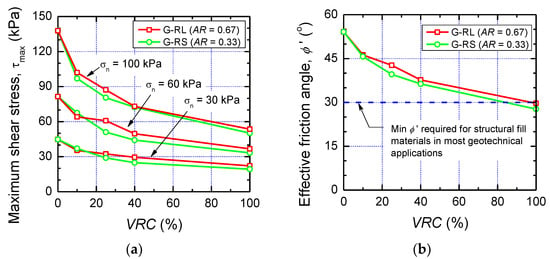
Figure 7.
Strength characteristics of GRMs: (a) variation of maximum shear stress with normal stress and VRC; and (b) variation of effective friction angle with VRC.
Figure 7b reports the values of the Mohr–Coulomb effective friction angle (ϕ’) for all mixtures. Essentially, ϕ’ decreased significantly with increasing VRC (and only slightly with AR) from about 54° (gravel) to 29° (graduated rubber). Notably, excluding G-RS with VRC > 85% and G-RL with VRC > 95%, most of the GRMs had a high strength (i.e., ϕ’ > 30°) regardless of the VRC and rubber particle size, making them potentially suitable structural fill materials for many geotechnical applications [17,19].
The packing properties of GRMs described earlier (Section 4.1) may provide valuable information on their mechanical behavior (refer to Figure 5, Figure 6 and Figure 7). Nonetheless, the load-transfer mechanism within the mixtures depends predominantly on the skeleton material [39,40,41], which is formed when particles of the same material are in contact with each other and are able to transfer loads. The material forming the skeleton becomes the matrix material that governs the general mechanical behavior of a mix. As shown by Figure 8, DEM-based micro-mechanical strong-force network analyses conducted by Chiaro et al. [43] have indicated that two matrix materials can be expected for GRMs: (i) a gravel matrix, leading to a stiffer gravel-like response of GRMs (VRC ≤ 30%); and (ii) a rubber matrix, producing a softer rubber-like behavior of GRMs (VRC ≥ 60%). In between, an intermediate gravel–rubber behavior will likely take place (30% < VRC < 60%). Such distinct behavioral zones provide a framework explaining the gradual change in behavior from stiff gravel-like to soft rubber-like, as observed in the direct shear tests.
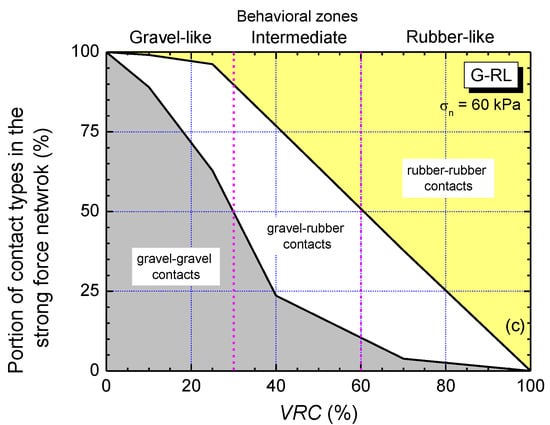
Figure 8.
Behavioral zones for GRMs in direct shear tests evaluated by DEM strong-force network analysis.
4.4. Stiffness, Shear Strain Degradation and Damping Properties
The design of geotechnical structures made of GRMs subjected to cyclic shear loading conditions (e.g., earthquake or traffic loads) will necessitate the estimation of the dynamic and cyclic behavior of the mixtures including the small-strain shear stiffness (Gmax), shear modulus (G) degradation, and damping ratio (D).
As shown in Figure 9, the results of bender element tests indicate that Gmax of GRMs decreased with increasing VRC and increased with confining pressure. This is essentially consistent with previous studies on sand–rubber mixtures [28]. However, for any given confining pressure value, it has been noticed that the Gmax of GRMs is generally greater than that of sand–rubber mixtures having the same VRC [39,41].
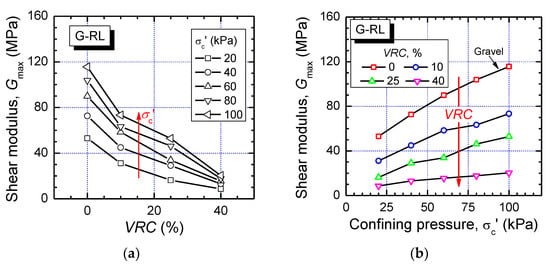
Figure 9.
Variation of small-strain shear modulus (Gmax) of G-RL with: (a) VRC, and (b) confining pressure (adopted from [16]).
On the other hand, the results of small-strain drained cyclic triaxial tests revealed that the addition of rubber aggregates into GRMs delays the G degradation on one side and increases D on the other (Figure 10). This is an important outcome demonstrating that GRMs will perform better than gravel only under cyclic loading, maintaining their initial stiffness and dynamic properties over a larger range of shear strains. Clearly, this is due to the ability of soft rubber particles to rebound and dissipate energy.
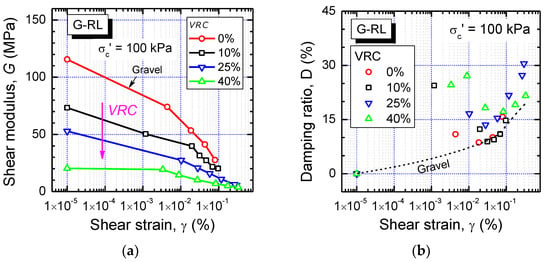
Figure 10.
Dynamic properties of GRMs evaluated by small-strain drained cyclic triaxial tests at 100 kPa confining pressure: (a) shear modulus degradation and (b) damping ratio.
4.5. Leaching Characteristics of GRMs
Tires are largely composed of carbon black, vulcanized rubber, rubberized fabric containing reinforcing textile cords, antioxidants, silica, pigments, process and extender oils, accelerators, and steel wire [4] and may contain petroleum residues acquired through use [44]. In this study, due to the recycled rubber’s proposed use in geotechnical applications, clarification was needed to understand whether and to what extent metals and inorganics could leach into the environment. This is to ensure that there are no negative, long-term impacts to the environment. Factors expected to affect the rate and concentration of tire leachate include the rubber particle size and content, contact time, and the aquatic or soil environments [6].
Within this scope, in this feasibility study, six pilot 28-day batch leaching tests were conducted on GRMs with VRC = 40% that were placed in deionized water (additional tests on GRMs with VRC = 0, 10, 25% are in progress and the results will be presented elsewhere). Samples were taken on days 0, 1, 2, 4, 7, 10, 14, 17, 21, 25, and 28 to track leaching characteristics, which were determined by ICP-MS analyses. The metals and organics tested for included aluminum (Al), arsenic (As), calcium (Ca), cadmium (Cd), cobalt (Co), chromium (Cr), copper (Cu), iron (Fe), potassium (K), magnesium (Mg), manganese (Mn), phosphorus (P), lead (Pb), sodium (Na), nickel (Ni), and zinc (Zn). Note that pH, conductivity, and TOC analyses were also performed and the details are reported in Banasiak et al. [7].
Table 3 summarizes the total average mass of predominant constituents leached for G-RL and G-RS mixtures, while Table 4 provides the maximum concentrations of all the tested elements. It is expected that the Ca, K, and Na contents are attributed to the gravel and the Zn and Mg to the tires. As an example, Zn concentrations measured during the entire 28-day leaching test period are reported in Figure 11.

Table 3.
Total mass of elements leached at 28 days (average values from 3 tests).

Table 4.
Maximum concentration of leachate elements obtained by ICP-MS analyses (average values from three tests).
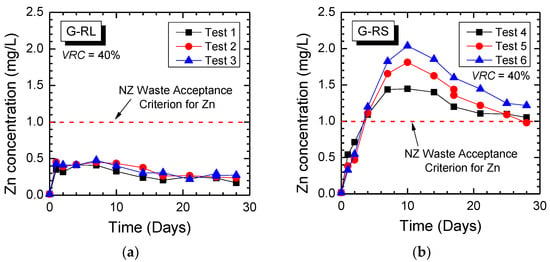
Figure 11.
Concentration of zinc from 28-day batch leaching tests on GRMs (VRC = 40%) placed in deionized water: (a) G-RL; and (b) G-RS mixtures.
The test results were compared to New Zealand Drinking Water Standards [45] and New Zealand Landfill Waste Acceptance Criteria [46] for class A and B leachability concentration limits. Class A landfills “provide a degree of redundancy for leachate containment” to “reduce the potential for adverse environmental effects” whereas class B landfills do not have such controls. Guideline values for Zn, Mn, Fe, and Al were exceeded. These values mean that there is an increased discoloration, taste, and staining risk.
From a practical viewpoint, these results highlighted that the leachate from smaller tire particles (G-RS) had a higher content of metals, implying that particle size and surface area influence the concentration of elements in GRM leachate. Additionally, the concentration of Zn in G-RS tests exceeded the leachability limit for class B landfills. Hence, G-RS mixtures would need to undergo pre-treatment if used in geotechnical works.
5. Design Considerations
GRMs are essentially lightweight materials (Figure 4). As a result, one of the benefits of using GRMs would be that the in situ overburden stresses associated with the self-weight of typical geomaterials could be greatly reduced. For instance, the reduction would be 6% for VRC = 10%, 13% for VRC = 25% and 23% for VRC = 40%. This is expected to lead to reduced design performance requirements, in terms of bearing capacity and settlement, for natural soil deposits that underlie a GRM layer installed as part of a residential structure foundation system or a geo-structure. Moreover, it would induce less settlement underneath embankments placed on compressible soil deposits or reduce the earth pressure behind retaining structures [16].
This study has demonstrated that GRMs have an adequate strength (i.e., ϕ’ > 30°) irrespective of the VRC and rubber particle size, making them suitable structural fill materials for many geotechnical applications. However, the ultimate adoption of GRMs as structural fills in geotechnical application would also depend on their compressibility under sustained loads (creep). As displayed in Figure 5, it is clear that the higher the vertical effective stress applied on GRMs, the higher the vertical strain developed, and the lower the VRC that may be accepted in the mixtures to satisfy compressibility requirements. Moreover, AR also plays a key role; in fact, for any combination of VRC and vertical effective stress, it can be observed that the mixtures with smaller rubber particles (G-RS) experience greater vertical strain compared to those with large rubber particles (G-RL). Therefore, to have GRMs with reduced compressibility, gravel and rubber particles with similar grain size should be used.
Permeability of GRMs can be related to the porosity of the mixes (which in turns depends on the particle size of rubber and gravel) as well as the vertical stress applied. Experimental evidence from relevant studies reported in the literature have shown that usually the hydraulic conductivity coefficient of soil–rubber mixtures with large rubber particles varies between that of typical gravelly soils at low confining stress levels and that of sandy soil at higher confining stress levels [36]. For mixtures of small rubber particles and VRC > 10%, the hydraulic conductivity coefficient was similar to that of sandy soils regardless of the confining stress applied [36]. In the case of foundations, retaining walls, and embankments, this means that GRMs will function as a free-draining fill material ensuring the rapid dissipation of excess pore water pressure. Remarkably, Hazarika et al. [30] reported that the use of GRMs (with VRC < 40%) placed on the top of liquefiable sandy soils can considerably reduce the pore water pressure generation in the sandy soil deposit, the reasons being: (1) GRMs themselves are not liquefiable and, therefore, can be conveniently used to replace the top most portion of liquefiable soil layers, and (2) having an hydraulic conductivity higher than the sand, GRMs provide a preferential pathway for water to easily flow upward and quickly dissipate pore water pressure.
The introduction of recycled ELT-derived materials in geotechnical applications may have benefits in terms of cost reductions and increased performance. However, it is essential to ensure that such innovations do not result in long-term negative impacts on the environment (e.g., through the leaching of toxic chemicals into the surrounding soil environment, groundwater, and surface water). The results of the leaching tests on GRMs have indicated that the leachate from smaller tire particles (RS) had a higher content of metals (e.g., Zn) compared to the large rubber one (RL), implying that particle size and surface area influence the concentration of elements in the GRM leachate. To minimize the leaching of metals, therefore, the use of larger rubber particle size is desirable. Otherwise, smaller rubber particles would need to undergo pre-treatment before use.
5.1. Proposed Acceptance Criteria for GRM Fill Materials (Static Loads)
In the case of most granular soils, design criteria based on frictional shear strength, bearing capacity, and permeability are used to evaluate their suitability as structural fill materials for geotechnical applications. It is often required that fills should possess a friction angle greater than or equal to 30° (and/or a California Bearing Ratio (CBR) > 10%), to guarantee a satisfactory shear resistance and to minimize post-construction settlement [17]. In addition, it is also recommended that fill material should have a permeability coefficient similar to that of sandy fills to ensure rapid dissipation of excess pore water pressure and to minimize internal erosion phenomena.
Because of the critical aspects identified in this study such as long-term creep compressibility and leaching of heavy metals, design criteria simply based on strength and permeability may not be sufficient to fully judge whether or not a GRM meets all the geotechnical requirements for structural fills. To overcome this issue, a modified framework with additional geotechnical design criteria including three levels of acceptance is proposed for GRMs (Figure 12):
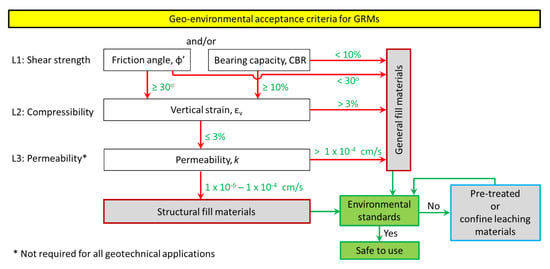
Figure 12.
Proposed geo-environmental acceptance criteria for use of GRMs in geotechnical applications.
- Level 1: Frictional shear resistance/bearing capacity. When used as structural fills, GRMs should possess adequate shear strength and bearing capacity to guarantee a satisfactory stability and reduced post-construction settlement. Specifically, GRMs should have a friction angle ϕ’ ≥ 30° and/or a CBR ≥ 10%. Otherwise, they should only be recommended as general fills.
- Level 2: Compressibility (most critical level). Since compressibility could continue for a long period of time, it is suggested that GRMs be accepted as structural fill only if the volumetric strain (εv) is ≤ 3%. Otherwise, they should only be recommended as general fills.
- Level 3: Permeability (not a critical level). In order to guarantee rapid dissipation of excess pore water pressure (i.e., maintaining relatively free-draining), it is recommended that GRM structural fills should have a permeability coefficient similar to that of sandy/gravelly fills (i.e., 1 × 10−6 cm/s ≤ k ≤ 1 × 10−4 cm/s). If k > 1 × 10−4 cm/s, GRMs could be used as general fills.
In addition to the above proposed geotechnical criteria, GRMs must also meet environmental standards (e.g., New Zealand Drinking Water Standards and New Zealand Landfill Waste Acceptance Criteria). Alternatively, pre-treatment or confinement of leached chemicals may be required.
5.2. Practical Application: Seismic Design of ERGSI Foundation Systems
“Eco-rubber geotechnical seismic-isolation foundation systems” or in short “ERGSI foundation systems” are integrated systems comprising two key elements (Figure 13):
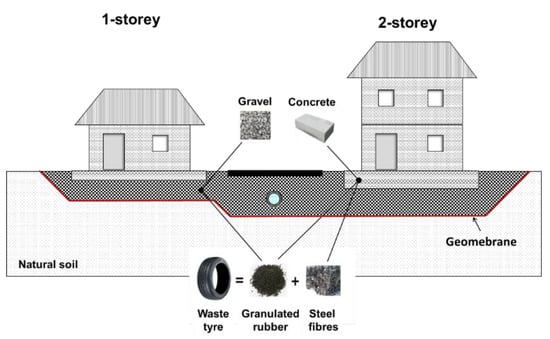
Figure 13.
Schematic illustration of the “Eco-rubber geotechnical seismic-isolation” (ERGSI) foundation systems (adopted from [16]).
- a seismic energy-absorption shallow horizontal layer of GRMs; and
- a flexible fiber-reinforced rubberized concrete raft foundation.
The geotechnical design of the GRM dissipative layer of a ERSGI foundation system requires considering not only the strength and compressibility criteria shown in Figure 12 (permeability is expected to be fulfilled given the fact that the GRMs are coarse granulated free-draining materials), but also the seismic performance of these synthetic materials.
Typically, in New Zealand, 1- to 2-storey timber-framed residential buildings transfer a vertical effective stress (σv’) from the structure to the foundation of 7–10 kPa and 10–15 kPa [47,48], respectively. Considering only G-RL (due to its acceptable leaching characteristics, Figure 11) from Figure 7b, it is evident that mixtures with VRC ≤ 95% would have a friction angle much greater than 30°, implying a good stability under static load conditions (σv’ ≤ 10–15 kPa) for both 1-storey and 2-storey buildings.
On the other hand, to guarantee the serviceability during and after the superstructure construction (i.e., to avoid damage to pipelines and other essential services that may be embedded in gravel-rubber foundation layer), and meet the compressibility criteria (εv ≤ 3%), it appears that only the G-RL mixtures with VRC ≤ 40–45% would be suitable for 1-storey buildings and those with VRC ≤ 35% would be suitable for 2-storey buildings (Figure 14).
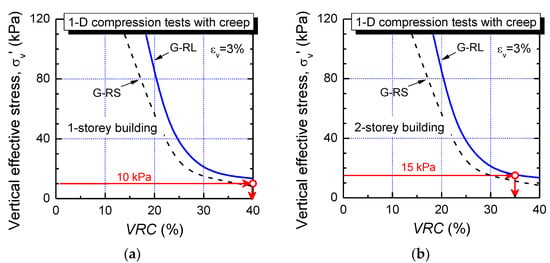
Figure 14.
Selection of suitable GRMs for foundation applications based on maximum allowable vertical strain (εv = 3% contours are derived from the 1-D compression test results shown in Figure 5): (a) 1-storey building; and (b) 2-storey building.
The seismic performance of ERGSI foundation systems was assessed by small-scale impact load tests conducted on GRMs [49]. In such pilot tests, a foundation prototype was placed on a 60 cm thick layer (made of mixtures with VRC = 0, 10, 25, and 40%). As shown in Figure 15, it was found that as more rubber aggregates were added into the mixtures, the natural frequency of the foundation system shifted toward a smaller value (base-isolation effect) while the amplitude of the output peak acceleration decreased (i.e., damping effect).
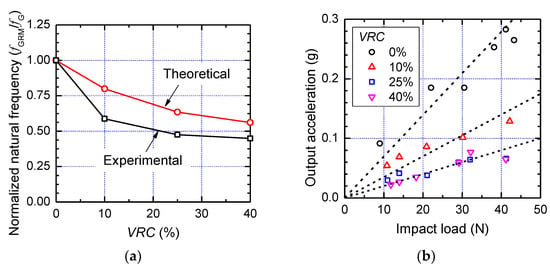
Figure 15.
Dynamic properties of G-RL mixtures from impact load tests: (a) decay of natural frequency with increasing VRC; and (b) reduction in output acceleration with increasing VRC.
It is also evident that even a small amount of rubber (i.e., VRC = 10%) contributes significantly in the dissipation of seismic energy. On the other hand, VRC of 25% and 40% seem to provide the same dissipative effects.
Based on the above, it is recommended that the range of suitable GRMs for ERGSI foundation systems should be limited to VRC ≤ 40% and VRC ≤ 35% for 1-storey and 2-storey buildings, respectively. However, to achieve the best seismic performance in terms of seismic isolation and energy dissipation, it was eventually suggested to use 25% ≤ VRC ≤ 35–40%.
6. Conclusions
In New Zealand, every year, approximately 3.5 million ELTs are legally or illegally disposed of through landfills and stockpiles. However, ELTs cannot be considered as a simple waste to be disposed of. Large-scale sustainable recycling initiatives are crucial to tackle this nationwide problem. A promising solution is to reuse ELTs in the form of recycled granulated rubber as construction materials in civil engineering applications. In this context, this paper has presented: (i) the results of geotechnical and environmental investigations assessing the potential use gravel–rubber mixtures (GRMs) as structural fills for geotechnical applications (including seismic-isolation foundation systems), and (ii) a framework with a set of geo-environmental criteria for the acceptance of GRMs as geo-structural fills.
The following main conclusions can be drawn from this study:
- the compressibility of GRMs is highly influenced by the rubber content and the rubber size. The higher the VRC and the smaller the rubber size, the more compressible the mixtures;
- irrespective of the applied normal stress level and rubber particle size (or aspect ratio, AR), the direct shear response of GRMs changed rapidly from dilative-like to contractive-like with the addition of rubber in the mixtures; nevertheless, independently from AR, the effective friction angle (ϕ’) was found to be between 54° (gravel) and 29° (rubber);
- from an environmental viewpoint, the use of GRMs with larger gravel-size like rubber particles (free from steel wires) is desirable since it would minimize the leaching of toxic metals (e.g., Zn) from the granulated rubber;
- GRMs with volumetric rubber content (VRC) ≤40% and gravel-size like rubber particles have satisfactory strength (i.e., friction angle >30°), low compressibility (long-term vertical strain ≤3%) and minimal leaching characteristics that make it possible to use GRMs as structural fills in many sustainable geotechnical applications; and
- specifically to the case of foundation systems, it was demonstrated that GRMs with 25% ≤ VRC ≤ 40% have excellent seismic-isolation and energy dissipation properties. As a result, their use can be particularly beneficial in applications aimed at enhancing the seismic resilience of low-rise light-weight residential buildings.
Future works. Note that the results reported in this paper are based on the use of uniformly-graded gravel and granulated rubber with maximum particle diameters of approximately 10 mm that could be tested in the laboratory using conventional devices. However, as at the Geotechnical Laboratory of the University of Canterbury, the capability of conducting tests on geomaterials with larger particles has become possible, the authors plan to conduct further geotechnical investigation on GRMs with larger gravel particles (i.e., Dmax = 40 mm) that are commonly used in foundation applications and other geotechnical works in New Zealand. This will make it possible to verify some of the findings reported in this paper, and if required, refine the proposed acceptance criteria for GRMs as geo-structural fills.
To complement the batch leaching test results reported in this paper, additional leaching tests considering acid and alkaline solutions are intended. Moreover, a series of column tests will be conducted on 1-D consolidated GRMs with the aim of mimicking as much as possible the groundwater conditions and material properties underneath a foundation or geo-structure, and account for possible groundwater seasonal changes (i.e., repeated cycles of wet and drying) and the effect of 1-D compression on the leaching properties of GRMs.
Specifically for seismic-isolation foundation systems, the authors have planned to carry out detailed field testing on a large-scale prototype structure supported on ERGSI foundations. This is of paramount importance for several reasons: (i) to evaluate the response of the ERGSI foundation with realistic infinite boundary conditions (not feasible in the laboratory tests); (ii) to assess the effects that underlying site geology may have on the ERGSI foundation performance and design; (iii) to monitor and evaluate the long-term settlement and ensure that is within serviceable limits, and (iv) to use background seismicity to further assess the seismic performance of the foundation system.
Author Contributions
Conceptualization, G.C., A.P., L.B., and G.G.; Methodology, G.C. and L.B.; Investigation, A.T., G.C., A.M., and L.B.; Data curation, A.T., G.C., L.B., and G.G.; Writing—original draft preparation, A.T. and G.C.; Writing—review and editing, L.B., A.P., and G.G.; Project administration, G.C.; Funding acquisition, G.C., A.P., and L.B. All authors have read and agreed to the published version of the manuscript.
Funding
This research was funded by the Ministry of Business, Innovation, and Employment (MBIE) of New Zealand, MBIE Smart Ideas Endeavour Research Grant No. 56289.
Institutional Review Board Statement
Not applicable.
Informed Consent Statement
Not applicable.
Data Availability Statement
The data presented in this study are available on request from the corresponding author.
Acknowledgments
The laboratory assistance of Sean Rees is greatly appreciated. Figures adopted from [16] were republished with the permission of the New Zealand Geotechnical Society.
Conflicts of Interest
The authors declare no conflict of interest. The funders had no role in the design of the study; in the collection, analyses, or interpretation of data, in the writing of the manuscript, or in the decision to publish the results.
References
- Basel Convention Working Group. Technical Guidelines on the Identification and Management of Used Tyres; Document No. 10; Basel Convention on the Control of Transboundary Movements of Hazardous Wastes and Their Disposal: Basel, Switzerland, 1999. [Google Scholar]
- Ministry for the Environment. Waste Tyres Economic Research; Report 3; Ministry for the Environment: Wellington, New Zealand, 2015; p. 87. [Google Scholar]
- Cann, G. NZ’s Tyre Mountains Keep Growing in Absence of Recycling Scheme. The Press. Available online: https://www.stuff.co.nz/environment/92515136/millions-of-tyres-becoming-unrecyclable-in-absence-of-recycling-scheme (accessed on 8 July 2021).
- Torretta, V.; Rada, E.C.; Ragazzi, M.; Trulli, E.; Istrate, I.A.; Cioca, L.I. Treatment and Disposal of Tyres: Two EU Approaches. A Review. Waste Manag. 2015, 45, 152–160. [Google Scholar] [CrossRef] [PubMed]
- Lynch, P.; Gabolinscy, C.; Tyler, M.; Turner, N.; Caldwell, J.; Kim, N.; Latham, R.; Kirkham, A.; Middleton, N.; Weiss, S.; et al. Guidance for Storage and Stockpiling End of Life Tyres for Local Government; Report 5629; Waikato Regional Council: Hamilton, New Zealand, 2017; p. 14. [Google Scholar]
- Banasiak, L.; Chiaro, G.; Palermo, A.; Granello, G. Recycling of End-of-Life Tyres in Civil Engineering Applications: Environmental Implications. In Proceedings of the WasteMINZ 2019 Conference, Hamilton, New Zealand, 23–26 September 2019; pp. 1–15. [Google Scholar]
- Banasiak, L.; Chiaro, G.; Palermo, A.; Granello, G. Environmental Implications of the Recycling of End-of-Life Tires in Seismic Isolation Foundation Systems. Lect. Notes Civ. Eng. 2021, 144, 43–52. [Google Scholar]
- Dangerfield, E. Cause of Massive North Canterbury Tyre Fire ‘Unknown’, Investigation to Begin. The Press. Available online: https://www.stuff.co.nz/the-press/news/101790124/hundreds-of-tyres-on-fire-in-north-canterbury (accessed on 8 July 2021).
- Dangerfield, E. Community Asked to Call for Government to Combat Tyre Stockpiling Through Legislation. The Press. Available online: https://www.stuff.co.nz/the-press/news/north-canterbury/101908978/community-to-call-for-central-government-to-combat-tyre-stockpiling-through-legislation (accessed on 8 July 2021).
- Dangerfield, E. Tyre Pile in Amberley, North Canterbury, Still a Risk a Year after Huge Fire. The Press. Available online: https://www.stuff.co.nz/national/110835486/tyre-pile-still-a-risk-a-year-after-huge-fire (accessed on 8 July 2021).
- Dangerfield, E. Number of Stockpiled Tyres Underestimated by Environment Canterbury. The Press. Available online: https://www.stuff.co.nz/the-press/news/north-canterbury/111551658/number-of-stockpiled-tyres-underestimated-by-environment-canterbury (accessed on 8 July 2021).
- Rowhani, A.; Rainey, T.J. Scrap Tyre Management Pathways and Their Use as a Fuel—A Review. Energies 2016, 9, 888. [Google Scholar] [CrossRef]
- Pehlken, A.; Essadiqi, E. Scrap Tire Recycling in Canada; CANMET Materials Technology Laboratory: Hamilton, ON, Canada, 2005. [Google Scholar]
- Waste Avoidance and Resource Recovery Act 2001 No 58. Available online: https://www.legislation.nsw.gov.au/#/view/act/2001/58 (accessed on 1 March 2021).
- Constant, D.; Gosmann, D. Tire Derived Fuel Use in Cement Kilns. GCI Tech. Notes 1997, 3. Available online: https://gcisolutions.com/library/gci_tech_notes/gcitn199709.html (accessed on 19 July 2021).
- Chiaro, G.; Tasalloti, A.; Banasiak, L.; Palermo, A.; Granello, G.; Rees, S. Sustainable Recycling of End-of-Life Tyres in Civil (Geotechnical) Engineering Applications: Turning Issues into Opportunities in the New Zealand Context. N. Z. Geomech. News 2020, 99, 38–47. [Google Scholar]
- Arulrajah, A.; Narsilio, G.; Kodikara, J.; Orense, R.P. Key Issues in Environmental Geotechnics: Australia-New Zealand. Environ. Geotech. 2015, 6, 326–330. [Google Scholar] [CrossRef]
- Chiaro, G.; Indraratna, B.; Tasalloti, S.M.A.; Rujikiatkamjorn, C. Optimisation of Coal Wash–Slag Blend as a Structural Fill. Ground Improv. 2015, 168, 33–44. [Google Scholar] [CrossRef] [Green Version]
- Rujikiatkamjorn, C.; Indraratna, B.; Chiaro, G. Compaction of Coal Wash to Optimize its Utilization as Water-Front Reclamation Fill. Geomech. Geoeng. 2013, 8, 36–45. [Google Scholar] [CrossRef]
- Tasalloti, S.M.A.; Indraratna, B.; Rujikiatkamjorn, C.; Heitor, A.; Chiaro, G. A Laboratory Study on the Shear Behavior of Mixtures of Coal Wash and Steel Furnace Slag as Potential Structural Fill. Geotech. Test. J. 2015, 38, 361–372. [Google Scholar] [CrossRef] [Green Version]
- Qi, Y.; Indraratna, B.; Twak, M. Use of Recycled Rubber Elements in Track Stabilisation. Geotech. Spec. Publ. 2020, GSP319, 49–59. [Google Scholar]
- Ghorbani, B.; Arulrajah, A.; Narsilio, G.; Horpibulsuk, S.; Bo, M.W. Dynamic Characterization of Recycled Glass-Recycled Concrete Blends Using Experimental Analysis and Artificial Neural Network Modeling. Soil Dyn. Earthq. Eng. 2021, 142, 106544. [Google Scholar] [CrossRef]
- Arulrajah, A.; Naeini, M.; Mohammadinia, A.; Horpibulsuk, S.; Leong, M. Recovered Plastic and Demolition Waste Blends as Railway Capping Materials. Trans Geotech. 2020, 22, 100320. [Google Scholar] [CrossRef]
- Chiaro, G.; Palermo, A.; Granello, G.; Banasiak, L. Direct Shear Behaviour of Gravel-Granulated Tyre Rubber Mixtures. In Proceedings of the 13th Australia New Zealand Conference on Geomechanics, Perth, Australia, 1–3 April 2019; p. 6. [Google Scholar]
- Chiaro, G.; Palermo, A.; Granello, G.; Tasalloti, A.; Banasiak, L. Reuse of Waste Tires to Develop Eco-Rubber Seismic-Isolation Foundation Systems: Preliminary Results. Lect. Notes Civ. Eng. 2021, 144, 159–169. [Google Scholar]
- Hernández, E.; Palermo, A.; Granello, G.; Chiaro, G.; Banasiak, L.J. Eco-rubber Seismic-Isolation Foundation Systems: A Sustainable Solution for the New Zealand Context. Struct. Eng. Int. 2020, 30, 192–200. [Google Scholar] [CrossRef]
- American Standards for Testing Materials (ASTM). Standard Practice for Use of Scrap Tires in Civil Engineering Applications; American Society for Testing and Materials: West Conshohocken, PA, USA, 2017. [Google Scholar]
- Senetakis, K.; Anastasiadis, A.; Pitilakis, K. Dynamic Properties of Dry Sand/Rubber (SRM) and Gravel/Rubber (GRM) Mixtures in a Wide Range of Shearing Strain Amplitudes. Soil Dyn. Earthq. Eng. 2012, 33, 38–53. [Google Scholar] [CrossRef]
- Mashiri, M.; Vinod, J.; Sheikh, M.N.; Tsang, H.-H. Shear Strength and Dilatancy Behaviour of Ssand-Tyre Chip Mixtures. Soils Found. 2015, 55, 517–528. [Google Scholar] [CrossRef] [Green Version]
- Hazarika, H.; Pasha, S.M.K.; Ishibashi, I.; Yoshimoto, N.; Kinoshita, T.; Endo, S.; Karmokar, A.K.; Hitosugi, T. Tire-Chip Reinforced Foundation as Liquefaction Countermeasure for Residential Buildings. Soils Found. 2020, 60, 315–326. [Google Scholar] [CrossRef]
- Balaji, P.; Dashti, S.; Liel, A.B. In-Ground Gravel–Rubber Panel Walls to Mitigate and Base Isolate Shallow-Founded Structures on Liquefiable Ground. J. Geotech. Geoenviron. Eng. 2020, 146, 04020087. [Google Scholar] [CrossRef]
- Tsang, H.-H.; Lo, S.H.; Xu, X.; Sheikh, M.N. Seismic Isolation for Low-to-Medium-Rise Buildings Using Granulated Rubber-Soil Mixtures: Numerical Study. Earthq. Eng. Struct. Dyn. 2012, 41, 2009–2024. [Google Scholar] [CrossRef]
- Tsiavos, A.; Alexander, N.A.; Diambra, A.; Ibraim, E.; Vardanega, P.J.; Gonzalez-Buelga, A.; Sextos, A. A Sand-Rubber Deformable Granular Layer as a Low-Cost Seismic Isolation Strategy in Developing Countries: Experimental Investigation. Soil Dyn. Earthq. Eng. 2019, 125, 105731. [Google Scholar] [CrossRef]
- Dhanya, J.S.; Boominathan, A.; Banarjeee, S. Performance of Geo-Base Isolation System with Geogrid Reinforcement. Int. J. Geomech. 2018, 19, 04019073. [Google Scholar] [CrossRef]
- Pitilakis, D.; Anastasiadis, A.; Vratsikidis, A.; Kapouniaris, A.; Massimino, M.R.; Abate, G.; Corsico, S. Large-Scale Field Testing of Geotechnical Seismic Isolation of Structures Using Gravel-Rubber Mixtures. Earthq. Eng. Struc. Dyn. 2021, 50, 2712–2731. [Google Scholar] [CrossRef]
- Tasalloti, A.; Chiaro, G.; Murali, A.; Banasiak, L. Physical and Mechanical Properties of Granulated Rubber Mixed with Granular Soils—A Literature Review. Sustainability 2021, 13, 4309. [Google Scholar] [CrossRef]
- Hazarika, H.; Abdullah, A. Improvement Effects of Two and Three Dimensional Geosynthetics Used in Liquefaction Countermeasures. Jpn. Geotech. Soc. Spéc. Publ. 2016, 2, 2336–2341. [Google Scholar] [CrossRef] [Green Version]
- Tasalloti, A.; Chiaro, G.; Banasiak, L.; Palermo, A. Experimental Investigation of the Mechanical Behaviour of Gravel-Granulated Tyre Rubber Mixtures. Constr. Build. Mater. 2021, 273, 121749. [Google Scholar] [CrossRef]
- Lee, J.-S.; Dodds, J.; Santamarina, J.C. Behavior of Rigid-Soft Particle Mixtures. J. Mater. Civ. Eng. 2007, 19, 179–184. [Google Scholar] [CrossRef] [Green Version]
- Pasha, S.M.K.; Hazarika, H.; Yoshimoto, N. Physical and Mechanical Properties of Gravel-Tire Chips Mixture (GTCM). Geosynth. Int. 2019, 26, 92–110. [Google Scholar] [CrossRef]
- Kim, H.-K.; Santamarina, J.C. Sand-rubber mixtures (large rubber chips). Can. Geotech. J. 2008, 45, 1457–1466. [Google Scholar] [CrossRef] [Green Version]
- Tasalloti, A.; Chiaro, G.; Palermo, A.; Banasiak, L. Effect of Rubber Crumbs Volumetric Content on the Shear Strength of Gravelly Soil in Direct Shear Apparatus. Geotech. Spec. Publ. 2020, 319, 259–266. [Google Scholar] [CrossRef]
- Chiaro, G.; Tasalloti, A.; Chew, K.; Vinod, J.S.; Allulakshmi, K. Macro- and Micro-Scale Engineering Response of Rigid-Soft Gravel-Rubber Inclusions: Insights from Detailed Laboratory and DEM Numerical Investigations. Lect. Notes Civ. Eng. 2021, 16, in press. [Google Scholar]
- Edil, T.B. A Review of Environmental Impacts and Environmental Applications of Shredded Tire Scraps. In Proceedings of the International Workshop IW-TDGM 2007, Yokosuka, Japan, 23–24 March 2007; Taylor & Francis Group: London, UK, 2007. [Google Scholar]
- Ministry of Health. Drinking Water Standards for New Zealand; Ministry of Health: Wellington, New Zealand, 2018.
- Ministry for the Environment. New Zealand Landfill Waste Acceptance Criteria—Module 2: Hazardous Waste Guidelines; Ministry for the Environment: Wellington, New Zealand, 2004.
- Thurston, S.J. Base Isolation of Low Rise Light and Medium-Weight Buildings; BRANZ Study Report No. 156; 2006; BRANZ Ltd.: Judgeford, New Zealand.
- Jampole, E.; Deierlein, G.; Miranda, E.; Fell, B.; Swensen, S.; Acevedo, C. Full-Scale Dynamic Testing of a Sliding Seismically Isolated Unibody House. Earthq. Spectra 2016, 32, 2245–2270. [Google Scholar] [CrossRef]
- Tasalloti, A.; Chiaro, G.; Young, J.; Ross, O.; Palermo, A.; Granello, G. Experimental Seismic Characterisation of Gravel-Granulated Tyre Mixtures and Design Implications. In Proceedings of the 2021 New Zealand Society of Earthquake Engineering Annual Conference, Christchurch, New Zealand, 14–16 April 2021; p. 10. [Google Scholar]
Publisher’s Note: MDPI stays neutral with regard to jurisdictional claims in published maps and institutional affiliations. |
© 2021 by the authors. Licensee MDPI, Basel, Switzerland. This article is an open access article distributed under the terms and conditions of the Creative Commons Attribution (CC BY) license (https://creativecommons.org/licenses/by/4.0/).